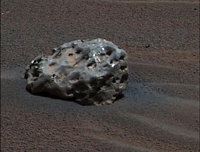Meteoritics and notable cases
![]() This is where an important area of study arises, where especially hobbyists can make contributions. It's about the meteoritic, the study of these bodies from space and the information they contain inside. Without a doubt, meteorites have been falling on Earth long before Man appeared, and throughout History these rocks have received different interpretations: gifts from gods, sources of worship or divine punishments. Some of the largest meteorites weigh more than 100 kilos, and in many cases they have involved direct witnesses.
This is where an important area of study arises, where especially hobbyists can make contributions. It's about the meteoritic, the study of these bodies from space and the information they contain inside. Without a doubt, meteorites have been falling on Earth long before Man appeared, and throughout History these rocks have received different interpretations: gifts from gods, sources of worship or divine punishments. Some of the largest meteorites weigh more than 100 kilos, and in many cases they have involved direct witnesses.
Some of the most famous events of this type are the meteorite hoba found in Namibia (the heaviest in the world at 60 tons), the Tunguska event (although it is not really clear if what fell was an asteroid or comet), the meteorite ALH84001 fallen in Antarctica, coming from Mars, sparking controversy at the time for containing what seemed like fossil samples of microscopic life, and, by the way, the event that extinct the dinosaurs 65 million years ago, whose crater would correspond to the from Chicxulub, on the Yucatan Peninsula (Mexico).
 Meteorites are classified (among other things) by their composition. These might be rocky, metallic or one mix, highlighting silicate minerals in the case of rocky ones, and iron-nickel for metallic ones. A high majority (85%) are composed of silicates, while only 5% are metallic, and it is thought that many come from the break-ups of larger asteroids, when the Solar System was just forming. However, the vast majority of space objects that reach Earth disintegrate in its atmosphere and only a few manage to cross this barrier and survive.
Meteorites are classified (among other things) by their composition. These might be rocky, metallic or one mix, highlighting silicate minerals in the case of rocky ones, and iron-nickel for metallic ones. A high majority (85%) are composed of silicates, while only 5% are metallic, and it is thought that many come from the break-ups of larger asteroids, when the Solar System was just forming. However, the vast majority of space objects that reach Earth disintegrate in its atmosphere and only a few manage to cross this barrier and survive.
Due to their characteristics, the most feasible way to locate them is by searching in flat places, such as deserts or frozen terrain. There are techniques to recognize them, although it requires an arduous search task for those who dedicate themselves to this discipline.
In addition to the casual observation of meteors or fireballs, there is a striking and visible phenomenon at different times of the year, called meteor shower, in which we can see a large number of flashes in a specific region of the sky. It's just one of many others celestial phenomena that are within our reach and that you can review on this site.

